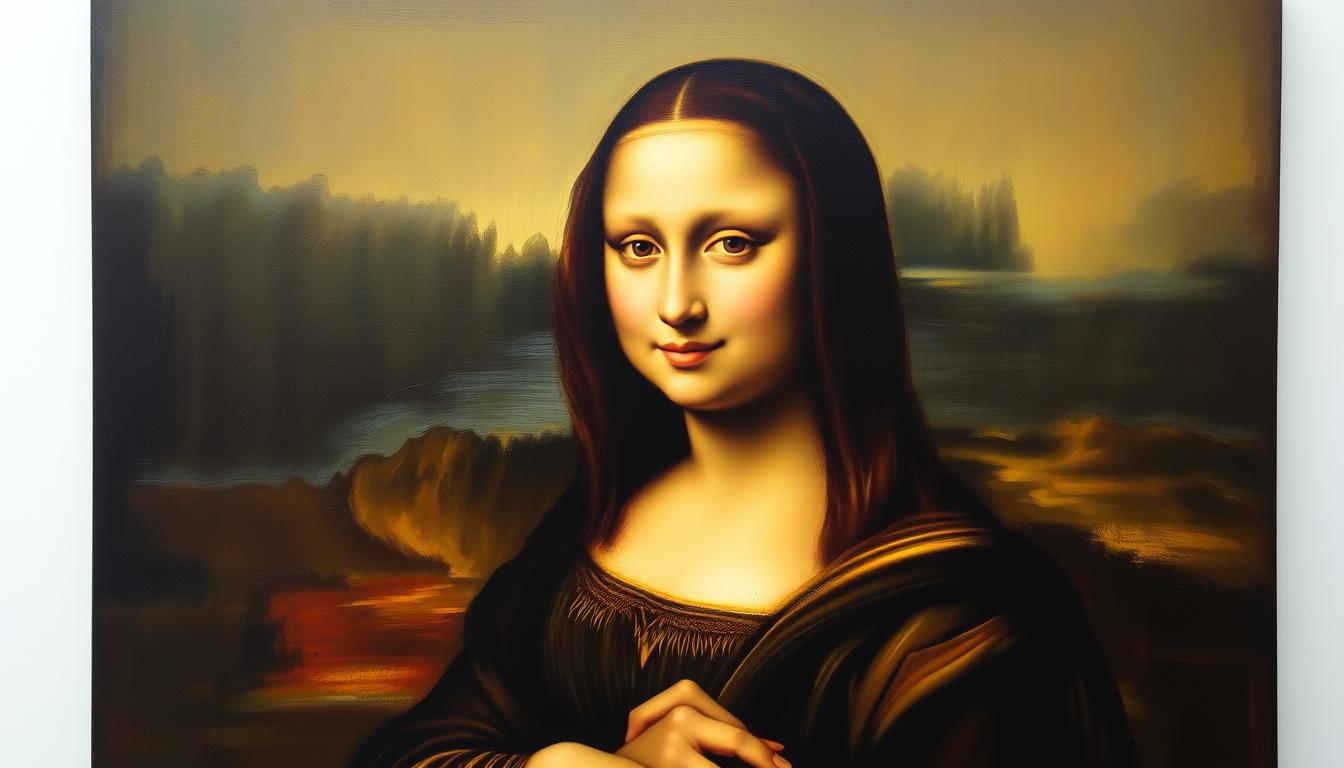What makes a small, quiet portrait draw crowds from around the world?
Seen up close, many people feel surprised: the work is modest in scale, yet its name towers over nearly every other piece of art. That rise came from a blend of Leonardo’s technical mastery and a long chain of events that gave the image huge reach.
The portrait’s lifelike gaze and subtle smile created lasting mystery. A royal-to-public journey, a sensational 1911 theft, modern parodies by artists like Duchamp and Warhol, blockbuster tours, and endless reproductions all amplified its appeal over years.
This iconic piece now hangs behind bulletproof glass at the Louvre, and its museum placement keeps steady visitor flow. Over time, media, technology, and tourism pushed the image beyond gallery walls into daily life and advertising.
In the sections ahead we will unpack the art itself, explore the sitter question, trace the theft and media impact, and show how celebrity culture secures its status as a global masterpiece.

Key Takeaways
- Fame grew from both artistic skill and a chain of historic events.
- Leonardo’s technique made the portrait feel vividly alive.
- High-profile theft and media attention boosted popularity.
- Museum placement at the Louvre gives unmatched visibility.
- 20th-century art and mass reproduction turned it into a cultural icon.
The many threads behind a single masterpiece’s fame
A mix of craft, court politics, and modern publicity lifted one small portrait into global view.
Technical skill met historical luck. Leonardo’s work left a deep mark in artistic technique, while Francis I brought the piece into royal circles during the 16th century. It stayed in palaces until revolutionary change moved collections into public hands.
A multi-cause story: inherent quality meets historical luck
Several threads intertwined across centuries: innovative studio methods, courtly prestige, political upheaval, and spectacle. Competing theories about fame exist, but most agree quality mattered alongside timing and repeated exposure.
From courtly collections to the world’s walls and screens
After a stint in Napoleon’s bedroom, the work landed in the Louvre in the early 19th century and became public. A 1911 theft sparked worldwide headlines, and 20th-century artists like Duchamp and Warhol, plus mass tourism and media tours, pushed the image into postcards, ads, and screens.
Today tens of thousands of people visit daily, and plans for a dedicated exhibition space keep interest high. That network of patrons, museums, press, and audiences explains a rise in popularity few other art objects have matched.
Inside the art: innovation, sfumato, and a lifelike gaze
Leonardo reshaped how a sitter could appear by blending science with delicate brushwork. He moved away from strict profiles and placed the figure in a three-quarter turn with hands shown. This creates a direct, human encounter that felt new in that era.
Sfumato plays a central role. Leonardo layered ultrathin glazes to blur edges and shifts of tone. The face reads like living skin; the smile seems to change when viewers shift focus or light shifts across the room.
His study of bones and muscles informed tiny cues around mouth and eyes. Vasari even claimed contemporaries could detect a pulse in her throat—an early note on the lifelike effect that took him many years to build.

Landscape and lingering puzzles
The background adds mystery. Some research points to Romito di Laterina; others read geological markers near Lecco and Lake Como. Those competing theories keep attention on the work and its maker.
- Technique: sfumato and glazing create depth and atmosphere.
- Composition: three-quarter pose with hands adds presence.
- Inquiry: anatomical study made expression layered, not fixed.
"An image that feels alive changed how peers would paint portraits for generations."
| Feature | Effect | Legacy |
|---|---|---|
| Sfumato glazing | Soft transitions; living skin tone | Influenced portrait realism |
| Three-quarter pose + hands | Human presence; psychological contact | Common in later portraits |
| Detailed landscape | Ongoing geographic debates | Continues scholarly interest |
For a deeper look at how historical events amplified this fame story, see this overview.
Why is the Mona Lisa painting so famous?
Most scholars identify the sitter as Lisa Gherardini, the wife of a Florentine silk merchant, Francesco del Giocondo. That link ties this portrait to a real family and a clear social world: Florence’s merchant class in the early 1500s.
Yet uncertainty remains. No surviving commission record exists, and Leonardo Vinci kept the work with him rather than sending it to the del Giocondo home. That gap invites questions about intent, ownership, and how the portrait circulated.

The rise of myth across centuries
Romantic writers of the 19th century fed fascination. Critics recast the woman into a seductive legend. Some called her gaze strange or vampiric, while others elevated Leonardo into near-myth.
That storytelling turned identity doubt into allure. Ambiguity let viewers read the sitter as matron, muse, or enigma. Over time, narrative and technique worked together to enlarge fame.
"Uncertainty about the sitter made room for centuries of storytelling."
- Accepted ID: Lisa Gherardini, wife of merchant Francesco del Giocondo.
- Lingering mystery: no commission record; Leonardo kept the work.
- 19th-century mythmaking amplified both sitter and artist into legend.
For a practical guide to provenance and lore, see the Mona Lisa history and mystery.
Scandal, media, and modernity: how the 20th century supercharged her renown
A stolen canvas, relentless headlines, and public spectacle rewired how people saw art.
The 1911 heist: an empty wall becomes a story
On August 21, 1911, vincenzo peruggia removed the mona lisa from the wall, hid overnight, and walked out the next morning.
The empty space at the Louvre drew crowds at once. Newspapers ran bold front‑page coverage and the museum’s painting director resigned. Even pablo picasso faced arrest in the frenzy of suspicion.
Two years later a Florence dealer alerted police after peruggia tried to sell the work. The recovered painting toured Italy before returning to Paris, and the episode shifted this painting into public obsession.
Parody, appropriation, and artistic spotlight
Marcel Duchamp’s 1919 prank turned a postcard into a cultural flashpoint. His mustachioed copy sparked waves of reinterpretation.
Years later, artists such as Andy Warhol repeated the image, keeping the portrait in headlines and galleries. Parody acted like publicity, raising status inside the modern painting world.
Blockbuster tours and mass celebrity
In 1963 a U.S. tour drew roughly 1,751,521 visitors in six weeks across Washington and new york. Years later a Japan tour in 1974 produced similar daily lines and media attention.
These events proved that modern travel, press, and celebrity culture can turn one canvas into global spectacle.
"The theft transformed a respected masterpiece into a figure of worldwide fascination."
| Event | Date / Year | Impact | Notable Names |
|---|---|---|---|
| Theft and recovery | 1911 — recovered two years later | Mass headlines; national pride; museum reforms | vincenzo peruggia; Florence dealer |
| Artistic appropriation | 1919 onwards | Renewed critical debate; pop culture visibility | Marcel Duchamp; Andy Warhol; pablo picasso mentioned |
| International tours | 1963 (US), 1974 (Japan) | Record crowds; celebrity status cemented | Washington, new york, Tokyo museums |
The Louvre effect: museum power, tourism, and cultural celebrity
From a royal collection to a guarded gallery wall, its home shaped public meaning. Leonardo brought the work to France late in his life, and king francis added it to a royal collection that later merged into national holdings.
From Francis I’s collection to the Salle des États: a national treasure behind glass
Today the mona lisa sits in the Louvre’s Salle des États, mounted on a single wall and protected by bulletproof glass. That setup reads like ceremony: careful lighting, crowd control, and a display that signals national pride and cultural security.
Mass visitorship and pop-cultural cameos: Beyoncé & Jay‑Z to Lady Gaga
Estimates put daily visitors at tens of thousands, and about 80% of people name this work as their main reason to visit. Plans for a dedicated entrance and exhibition space show how the museum adapts to protect access while preserving the object over time.
Celebrity moments keep the image current. High‑profile cameos—such as Beyoncé & Jay‑Z’s video and a Lady Gaga appearance—send millions back to images of the gallery and renew global interest.
- Collection to home: royal acquisition by king francis anchored long-term care and display.
- Display: a dedicated wall and bulletproof case create a focused viewing ritual.
- Scale: 20,000–30,000 visitors daily, most arriving for this work.
- Visibility: pop culture and tours keep the image circulating worldwide.
"Institutional stature, protective display, and popular visibility make it a perennial magnet for visitors and media."
For further reading on how museum context affects legacy, see a concise overview at this artnews piece.
Conclusion
, An artwork attains lasting renown through both subtle skill and dramatic events.
In short: the mona lisa earned its name because Leonardo’s technical subtlety met moments that amplified reach. Its sfumato, three-quarter pose, and lifelike gaze give the portrait a shifting, human quality. Those choices reflect the mind of a master painter and add depth to her smile and life on canvas.
Outside the studio, theft, headlines, and repeated appropriation by an artist and advertisers pushed the image across the painting world. International tours and media cycles turned local fame into global popularity.
At the Louvre a guarded display and huge visitor numbers keep the work current year after year. Across century after century people meet the masterpiece in scholarship, selfies, and song. That mix of craft, story, and constant exposure explains why the mona lisa still moves people around the world.
Enhance Your Space with Unique Modern Masterpieces
Are you inspired by the innovative mediums and conceptual depth highlighted in our exploration of contemporary art? You’re not alone! Today’s art enthusiasts are seeking cultural relevance and emotional connections in their artwork. However, finding pieces that resonate with modern themes and fit your unique style can be a challenge. That’s where we come in!
At Rossetti Art, we specialize in canvas prints, original paintings, and modern sculptures that celebrate the spirit of now. Each piece created by Chiara Rossetti brings a personal touch that connects deeply with current social narratives—just like the modern masterpieces discussed in the article. Don’t miss out on the chance to elevate your home decor with breathtaking artwork that speaks to your values and aesthetic. Explore our collection today and find your perfect piece! Act now, and transform your space into a gallery of inspiration!
FAQ
Why does Leonardo da Vinci’s work draw so much attention?
Leonardo combined scientific study with artistic skill. His use of sfumato softened transitions, creating depth and lifelike skin tones. He studied anatomy, light, and perspective, producing a portrait that feels alive and mysterious to viewers.
What technical innovations in this portrait stand out?
The painting shows a subtle three-quarter pose and detailed hand placement, which were less common then. Leonardo’s delicate shading and layered glazes create a breathing quality. That technique made the sitter’s gaze and expression endlessly discussed by scholars.
Who was the sitter, and why does her identity matter?
Most historians accept Lisa Gherardini, wife of silk merchant Francesco del Giocondo, as the sitter. Linking the work to a real Florentine family grounds the portrait in history and fuels interest in the woman behind the image.
How did historic ownership help boost this work’s profile?
King Francis I acquired the painting for the French royal collection, moving it into prominent court circles. Later placement in public collections such as the Louvre turned it into a national treasure and a magnet for visitors worldwide.
Did any dramatic events increase public fascination?
Yes. The 1911 theft by Vincenzo Peruggia made international headlines. For two years the painting’s absence and eventual recovery transformed it into a global sensation and cemented its celebrity status.
How did modern art and media affect reputation?
Twentieth-century artists and mass media amplified the image through parody and homage. Figures like Marcel Duchamp, Pablo Picasso, and Andy Warhol referenced it, while films, music, and celebrity sightings kept it in the public eye.
Have scientific studies changed how people see it?
Conservation research and imaging revealed underdrawings, changes over time, and the layered technique behind the portrait. These findings deepen appreciation and spark new debates about the artist’s methods and intent.
What role does the Louvre play in the painting’s fame?
The museum’s display, security, and interpretation turned the canvas into an international attraction. The protected setting and heavy visitor traffic reinforce a sense of importance and cultural value.
How have exhibition tours affected global recognition?
Major loans to New York, Washington, and Tokyo drew massive crowds and media attention. These tours broadened public access and intensified worldwide interest in the work and its history.
Why do so many theories and myths surround this portrait?
The painting’s subtle expression invites interpretation. Scholars, writers, and the public have proposed ideas about the sitter’s identity, hidden meanings, and symbolic landscapes. That mystery keeps discussion alive across generations.






Leave a comment
This site is protected by hCaptcha and the hCaptcha Privacy Policy and Terms of Service apply.